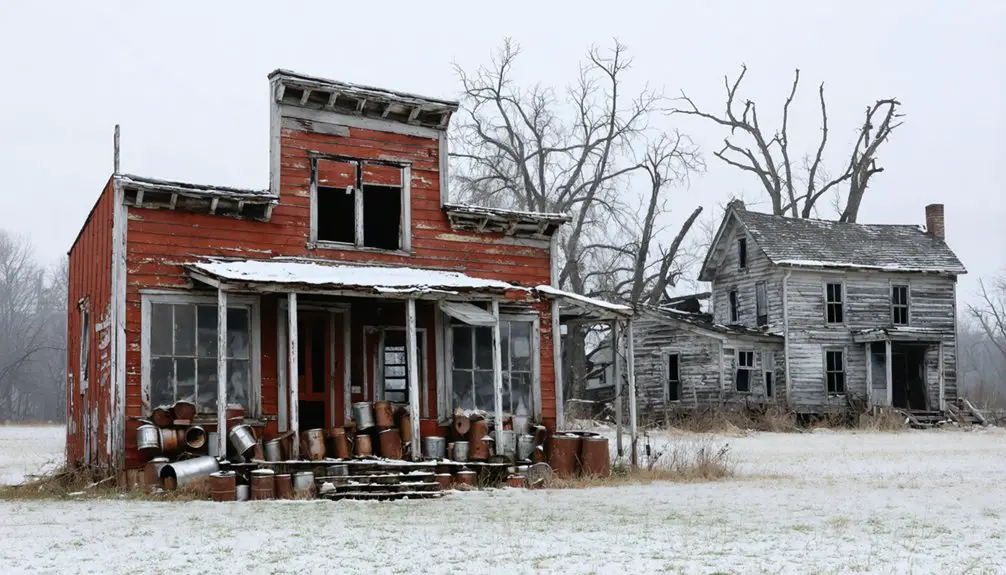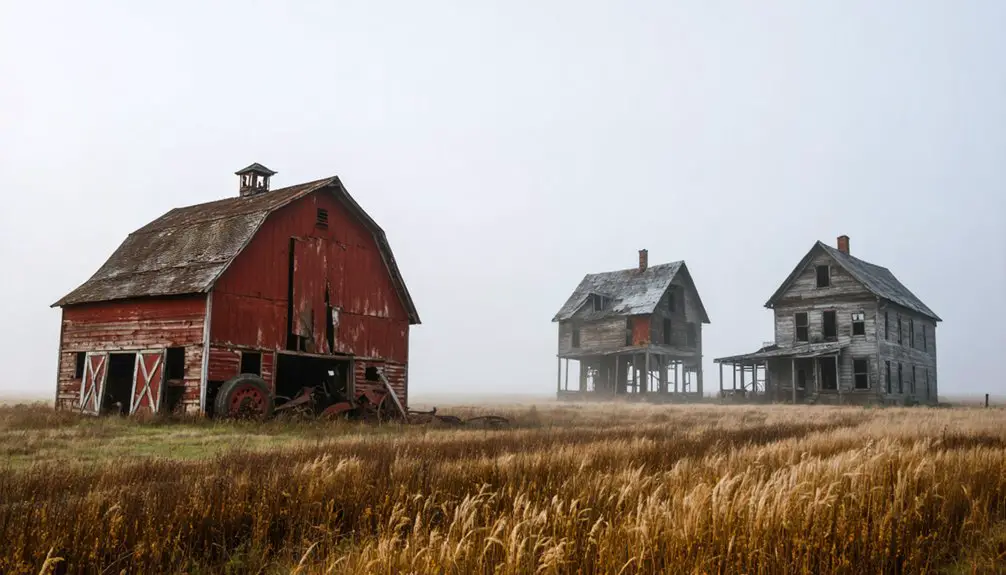You’ll find Hallock’s ghost town remains in Michigan’s Au Sable State Forest, about 14 miles northeast of Gladwin city. Founded in 1906 as a timber processing center, this once-bustling town thrived on lumber production and railroad commerce via the Boyne City, Gaylord & Alpena line. The town’s fortunes declined in the 1930s when timber resources dwindled, leading to its abandonment. Today, dense forest vegetation conceals fascinating remnants of Hallock’s brief but significant role in Michigan’s lumber era.
Key Takeaways
- Hallock was established in 1906 as a timber processing center in Michigan’s Au Sable State Forest, named after Benjamin Hallock.
- The town thrived on lumber production and railroad connections via the Boyne City, Gaylord & Alpena Railroad line.
- Infrastructure included three stores, a school, church, recreational hall, and sawmills serving Finnish and Scandinavian immigrant workers.
- Economic decline began in the 1930s due to depleted timber resources and Great Depression impacts.
- Today, dense vegetation covers the abandoned town site, with remaining evidence including mine shafts and railroad infrastructure remnants.
Location and Geographic Context
Nestled within Michigan’s Au Sable State Forest, the ghost town of Hard Luck sits at an elevation of 764 feet in Gladwin County’s Grim Township.
You’ll find this remote location at coordinates 44°04′18″N and 84°11′35″W, approximately 14 miles northeast of Gladwin city. The surrounding ecology features a mix of hardwood and conifer forests typical of northern Michigan’s landscape features. The area has been the subject of much confusion due to its disambiguation page status in historical records. Similar to how Hamlet village exists in Hayes County, Nebraska, Hard Luck represents another small, isolated settlement that time has largely forgotten.
Today, the site’s natural reclamation makes it challenging to explore, as vegetation rapidly overtakes any remaining traces of the past.
The terrain includes forested lowlands that once supported the area’s logging operations. You’ll need to navigate unmarked dirt and truck trails through dense forest to reach the location, as modern infrastructure and signage are virtually non-existent in this isolated part of the Au Sable State Forest.
Historical Origins and Settlement
You’ll find Hallock’s origins firmly rooted in Michigan’s lumber era, established in 1906 when the town emerged as a timber processing center in Elmira Township, Otsego County.
The settlement took its name from Benjamin Hallock, a local farmer whose presence predated the town’s founding.
Similar to communities like Arrol, the town employed Ottawa Indians as part of its lumber workforce.
The community’s growth followed typical patterns of early 20th-century lumber towns, with sawmills driving development and attracting a workforce of mainly Finnish and Scandinavian immigrants.
Lumber production in Michigan’s boom years reached an impressive 100 million board feet annually by the 1870s, setting the stage for towns like Hallock to emerge.
Early Settlement Patterns
During the early 1820s, Lewis Hallock established himself as the first pioneer settler in what would become Hallock Township, forging initial relationships with local Native tribes and paving the way for subsequent migrations.
Family migration patterns intensified by 1825, with settlers like the Reeds arriving from Ohio to form the first settlement clusters. The township’s twelve western sections, being mostly free of timber, attracted farmers seeking fertile agricultural land. Among the early settlers was Zadoc Hallock, who played a key role in establishing the first roads and community infrastructure.
You’ll find these early pioneers chose strategic locations near prairies, waterways, and transport routes.
By the 1830s, the Cliftons, Thomases, Merediths, and Cleavelands had settled the northern La Salle Prairie area. Joseph Meredith’s tavern became a crucial stopping point between Galena and Springfield.
The completion of the Erie Canal in 1825 accelerated westward movement, bringing more families like the Nurses from New York, who’d file their land claims at the Quincy Land Office.
Resource-Based Community Growth
As natural resources shaped Hallock’s early development, the community’s growth became inextricably linked to its agricultural and timber industries. Through collaborative resource management and strong social bonds, you’d find settlers working together to build a resilient community. Their bottom-up approach to development ensured community members actively participated in resource allocation decisions.
They established shared infrastructure, developed local governance systems, and created informal networks for knowledge exchange. This cooperative framework reflected elements of a resource based economy, emphasizing sharing over hoarding of community assets.
- Local leaders emerged from resource industries to guide sustainable extraction practices
- Community gatherings served as platforms for collective decision-making
- Settlers shared equipment and labor during peak harvest seasons
- Indigenous knowledge was integrated into resource management strategies
You’ll find that Hallock’s population ebbed and flowed with resource market demands, but the community’s collaborative spirit helped them weather economic uncertainties.
Their careful balance of exploitation and conservation guaranteed the town’s sustainability through its resource-dependent years.
Economic Activities and Local Industries
You’ll find that Hallock’s economy initially centered on lumbering, with the abundant white pine and hardwood forests attracting early settlers who established sawmills and logging operations.
The town’s strategic location on the Boyne City, Gaylord & Alpena Railroad line enabled the efficient transport of lumber, farm products, and manufactured goods to wider markets.
Local farmers supplemented their income by working in the forests during winter months, creating a seasonal rhythm between agricultural and logging activities.
The region experienced mining boom wealth, generating more prosperity than the California gold rush during America’s first copper mining operations.
A small gold mining operation in 1911 brought temporary excitement to the area, though it ultimately proved unsuccessful and was later suspected to be fraudulent.
Resource-Based Economic Activities
While establishing itself as a hub of natural resource industries, Hallock’s economy primarily revolved around lumbering and farming operations throughout its peak period.
You’d find local farmers diversifying their income by working in the forests during winter months, showcasing the region’s adaptive lumbering practices. The town’s agricultural trends centered around crop storage and processing, supported by essential facilities like the feed mill and potato warehouse.
- U.S. Plywood’s 1965 particleboard plant became the largest east of the Mississippi
- Local sawmills processed timber from nearby forests
- Feed mills supported the farming community’s needs
- Potato warehouses facilitated crop storage and distribution
The town’s resource-based economy later expanded beyond raw materials when the Gaylord Motor Company attempted automobile manufacturing, though timber and farming remained the backbone of local industry.
Early Transportation Networks
The Wisconsin & Michigan Railway transformed Hallock’s economic landscape in the late 19th century, establishing essential freight corridors for the town’s lumber and agricultural industries.
You’ll find that logging innovations, like Shay’s geared locomotives, revolutionized timber transport across the region’s challenging terrain. The railway invested heavily in specialized equipment, including box cars with end doors for loading forest products and upgraded tracks to handle heavier loads.
W&M’s extensive network connected Hallock to significant maritime routes via car ferries across Lake Michigan, enabling efficient freight movement of coal, lumber, and machinery.
These ferries linked the town to major ports like Peshtigo Harbor, where over 100 cars moved daily during peak operations. This integrated rail-maritime system proved essential for Hallock’s early growth as a lumber town.
Transportation Networks and Infrastructure
Transportation networks played a pivotal role in Hallock’s birth and eventual decline, with the Boyne City, Gaylord & Alpena Railroad serving as the town’s lifeline from its 1906 founding.
The town’s transportation history centered around the railroad’s strategic placement, which facilitated timber harvesting and later supported immigrant settlement.
- The BCG&A railroad was your connection to the wider world, with a depot handling both passenger and freight service.
- You’d find three stores, a school, church, and recreational hall built around the rail infrastructure.
- James J. Hill’s influence shaped the region’s transportation development, shifting from ox carts to modern rail systems.
You could witness the town’s infrastructure decline after 1935 when the BCG&A went bankrupt and tracks were dismantled.
The Path to Abandonment

Following decades of economic dependence on timber resources, Hallock’s path toward abandonment accelerated during the 1930s as multiple factors converged to seal its fate.
The Great Depression dealt a severe blow to the already fragile community dynamics, forcing many families to seek opportunities elsewhere. You’d have witnessed a steady exodus as younger residents moved to urban centers, leaving behind an aging population that couldn’t sustain local businesses and services.
Population trends showed a dramatic decline as the town’s economic foundation crumbled. Without a diversified economy to fall back on, each closure of a local store or service prompted more departures.
Each business closure triggered a chain reaction of departures, as residents sought stability beyond Hallock’s collapsing single-industry economy.
The dwindling tax base made it impossible to maintain essential infrastructure, creating a downward spiral that ultimately transformed Hallock from a bustling timber town into a ghost town.
Physical Remnants and Archaeological Evidence
Modern visitors to Hallock’s abandoned grounds can still find substantial evidence of its brief but bustling existence. Archaeological findings reveal a town shaped by railroad ambitions and mining dreams, though the latter proved futile.
The most prominent structural remains include two mine shafts, sunk 100 feet deep and heavily reinforced due to the region’s soft soil conditions.
- Mine shaft entrances and collars mark failed gold mining ventures from 1911
- Railroad infrastructure remnants from the Boyne City, Gaylord & Alpena line
- Farmstead foundations and cellar doors from early 20th-century settlements
- Environmental markers like altered landscapes and regrown vegetation over old homesteads
The site’s proximity to several northern Michigan rivers influenced settlement patterns, while water table issues ultimately prevented deeper mining operations, leaving these physical traces frozen in time.
Legacy and Historical Preservation
Despite its short-lived existence, Hallock’s legacy endures through extensive historical documentation and preservation efforts. You’ll find the town’s cultural significance preserved in company records, census data, and oral histories collected from descendants of former residents.
Local historical societies actively maintain these narratives through exhibitions and public talks, ensuring the mining town’s heritage isn’t lost to time.
Historical societies keep Hallock’s stories alive through public events, preserving the mining town’s rich heritage for future generations.
Today, preservation challenges are met through collaborative efforts between state and local groups who work to protect Hallock’s remaining structures. They’ve implemented protective measures against artifact removal and conduct detailed documentation through photographs and 3D modeling.
You can explore this heritage through guided tours, educational programs, and online platforms that share Hallock’s story, making it a valuable case study of early 20th-century mining communities in Michigan’s Upper Peninsula.
Frequently Asked Questions
Who Was Hallock Named After and Why Was This Name Chosen?
Like roots anchoring deep into Michigan soil, you’ll find Hallock’s origins stem from Benjamin Hallock, a prominent local farmer whose significance to the community inspired the town’s name during its 1906 founding.
Were There Any Notable Crimes or Mysterious Events in Hallock’s History?
You won’t find documented criminal activities or unsolved mysteries in this town’s records. Historical archives suggest it had typical frontier-era minor disputes, but nothing notable enough to make headlines.
What Happened to the Families Who Originally Lived in Hallock?
You’ll find that families scattered during community decline, with most relocating within Otsego County or larger Michigan towns. Family migration followed job opportunities as the lumber industry failed, breaking apart tight-knit community bonds.
Did Any Famous People or Significant Historical Figures Visit Hallock?
Despite searching through digital archives, you won’t find any famous visitors or significant historical figures who stopped in Hallock. The small lumber town’s brief existence didn’t attract celebrity appearances.
Are There Any Local Legends or Ghost Stories Associated With Hallock?
You won’t find documented ghost sightings or urban legends specific to this location, though many Michigan lumber towns developed supernatural tales about logging accidents and lost prosperity during their boom-and-bust cycles.
References
- http://www.otsego.org/ochs/Towns Red Buttons/GhostTowns/GhostTownsJumpPage.htm
- http://www.otsego.org/ochs/Affiliated Projects/HistoryMatters/Updates/Update8GhostTowns.pdf
- https://wrkr.com/blacksmith-star-corners/
- https://en.wikipedia.org/wiki/List_of_ghost_towns_in_Michigan
- https://en.wikipedia.org/wiki/Hard_Luck
- https://kellycodetectors.com/content/pdf/site_locator_books/MI.pdf
- https://latitude.to/articles-by-country/us/united-states/page/2775
- https://mapcarta.com/22336268
- https://www.nailhed.com/2019/07/hard-luck-and-tractor-henge.html
- https://www.nailhed.com/2017/10/the-ghost-town-that-moved.html



